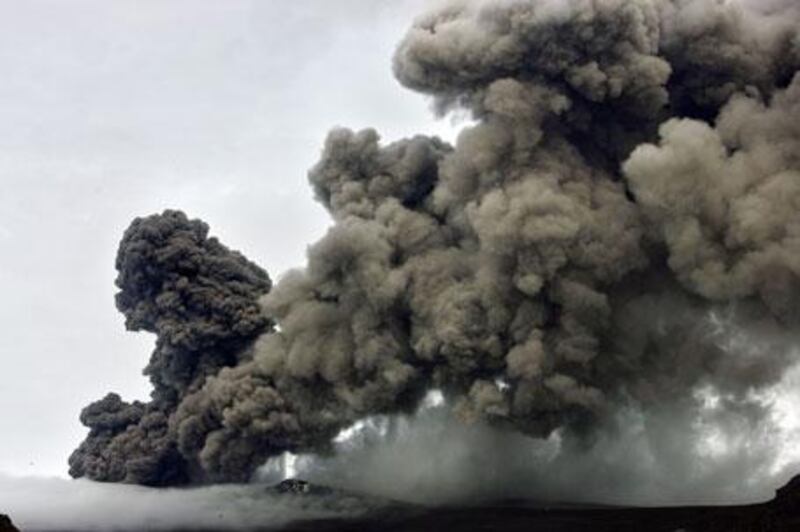DUBLIN // Iceland's volcano has produced a 1,600 kilometre-wide ash cloud off the west coast of Ireland that will force western Irish airports to shut down again today, the Irish Aviation Authority announced. The authority said shifting winds, currently coming from the north, had bundled recent days' erupted ash into a massive cloud that is growing both in width and height by the hour. Eurocontrol, which determines the air routes that airliners can use in and around Europe, says the ash accumulation is posing a new navigational obstacle - because the cloud is gradually climbing to 10,500 metres and into the typical cruising altitude of trans-Atlantic aircraft. Until recent days, the ash had remained below 6,000 metres.
The Irish Aviation Authority said the engine-wrecking ash would skirt Ireland's western shores today, forcing a half-dozen airports to ground flights for much of the day. However, the airports in Dublin, Cork in the south-west and Waterford in the south-east will remain open. "The restrictions are required as the increased level of recent volcanic activity has created a massive ash cloud stretching 1,000 miles long and 700 miles wide," the authority said in a statement.
The latest alert came only hours after British and Irish authorities declared the all-clear after much of the same ash was blown south-west from Scotland through Ireland on Tuesday and Wednesday, closing airports all along the way. Those were the first European air closures since the initial April 14-20 crisis, when ash from Iceland's Eyjafjallajokul volcano forced authorities across Europe to ground 100,000 flights and 10 million passengers.
Britain's Meteorological Office said that, given the direction of the winds, "the risk of the ash cloud affecting UK airspace in the next couple of days remains low." Eurocontrol, the continent's air traffic management agency in Brussels, also announced yesterday that it plans to reroute flights between Europe and North America to avoid flying over the ash cloud off Ireland's west coast. Until Eyjafjallajokul stops its emissions, the key to the future course of Europe's ash crisis will be the prevailing Atlantic winds.
When they blow to the north-east toward the unpopulated Arctic - the typical pattern in springtime - the danger to aircraft is minimised. But when they shift southward, as is happening this week and in mid-April, airlines' ability to land and depart safely is jeopardised. The Irish Aviation Authority said trans-Atlantic aircraft using Irish air space were already giving the ash cloud a wide berth by shifting their flight paths south.
The volcano, about 1,500 kilometres north-west of Ireland, has shown no signs of stopping since it began belching ash on April 13. The glacier-capped volcano last erupted sporadically from 1821 to 1823. In Iceland, civil protection official Agust Gunnar Gylfason said the volcano's eruption intensified on Wednesday and it continued to emit that higher volume of ash on Thursday. He said the ash plume's maximum altitude was oscillating between 6,000 and 9,000 metres.
*AP






